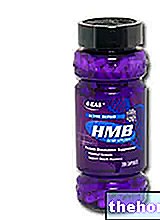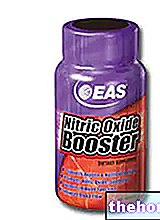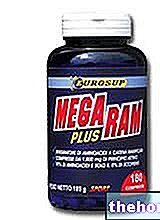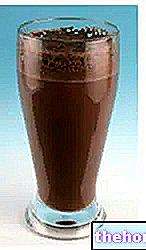
About GymLine Muscle Soy Power - Enervit
GYMLINE MUSCLE SOY POWER - ENERVIT
Food supplement of soy protein with branched chain amino acids and vitamin B6
FORMAT
Pack of 800 grams Cocoa, cream and cream flavor
COMPOSITION
Supro brand soy protein isolate; cocoa powder (2%); l-leucine (2%); flavorings; chocolate powder (1.1%) (cocoa mass, cocoa powder, cocoa butter, sugar, flavorings); l-isoleucine (1%); 1-valine (1%); acidity regulator: tripotassium citrate; thickener: carrageenan; anti-caking agent: silicon dioxide; sweetener: sucralose; microencapsulated vitamin B6 (vitamin B6, mono and diglycerides of fatty acids).
Average analysis
For 100 gr
per daily dose (30 g)
% RDA
Energy value
367 Kcal / 1558 Kj
110 Kcal / 467 Kj
-
Protein (N x 6.25)
84 g
25.2 g
-
Carbohydrates
2.35 g
0.7 g
-
Fat
0.6 g
0.18 g
-
L-Leucine
2 g
0.60 g
-
L-Valina
1 g
0.30 g
-
L-Isoleucine
1 g
0.30 g
-
Amino acid profile
Aminogram
Per 100 g of nitrogenous substance *
Isoleucine
5.75 g
Leucine
9.9 g
Lysine
5.94 g
Methionine
1.24 g
Phenylalanine
4.98 g
Threonine
3.55 g
Tryptophan
1.15 g
Valina
5.85 g
Histidine
2.49 g
Alanine
4.12 g
Arginine
7.18 g
Aspartic acid
11 g
Cysteine
1.25 g
Glutamic acid
18.19 g
Glycine
4 g
Proline
4.88 g
Serine
4.98 g
Tyrosine
3.55 g
Product features GymLine Muscle Soy Power - Enervit
Product features: the proteins in question are extracted from soy through a protocol known as SUPRO, patented by the company Solae. This particular extraction technique guarantees a high nutritional quality, which makes supro soy proteins particularly suitable for sports use.
To complete and improve the amino acid profile, the manufacturer has decided to add branched chain amino acids, thus optimizing their application in the sports sector and ensuring a useful protein content of over 80%. It is also worth noting the very high content of Arginine, significantly higher than that present in whey protein supplements.
Soy protein - very present in the oriental diet, they are slowly carving out an important space also in the western diet. Being vegetable proteins, they have an amino acid spectrum comparable to that of other legumes, therefore characterized by a reduced level of one or more essential amino acids, in this case the sulfurates (cysteine and methionine). Unlike other legumes, however, soy proteins have a more balanced pattern of essential amino acids and a greater bioavailability of the same. These two characteristics account for the good biological value, and for a protein quality comparable - according to the PDCAAS method - to that of animal proteins.

Despite these potential effects associated with the consumption of the legume in its entirety, soy and in particular its proteins have been received by the world of sports dietetics with widespread and unjustified skepticism. One of the main fears that dissuaded athletes from resorting to soy-based protein supplements was determined by the popular belief that the content of phytoestrogens, i.e. natural products with hormone-like action comparable to that of estrogen, could negatively affect the hormonal profile, reducing testosterone secretion and increasing estrogenic effects.
The scientific world has responded to these fears with a series of publications, which demonstrate that proteins derived from soy absolutely do not affect the hormonal profile. In addition, their integration guarantees the same anabolic effects of animal proteins or whey.
Consequently, while the introduction of soy-based foods is now indicated in menopausal women and in patients with manifest cardiovascular risk, there is no evidence showing an alteration of the hormonal profile in athletes who also use soy protein powder daily. .
Soy proteins in sports dietetics: false beliefs about possible estrogenic effects have been disproved, soy proteins are fully merited among the most used protein supplements by athletes of various disciplines. The use of these proteins has become particularly important for individuals subject to allergies of various kinds to milk or eggs or for those who, by choice, prefer not to consume products of animal origin, thus being able to ensure the correct protein intake without having to resort to "excessive consumption of legumes and encountering related undesirable effects.
In addition to the actual usefulness, the presence of various studies in the literature has justified the use of these proteins in the common supplementary practice, recording a series of beneficial effects for the "life" of athletes, totally comparable to those observed for whey proteins. among which:
- Hypertrophic effect: correct supplementation, combined with regular physical exercise, guarantees a significant increase in lean mass;
- Adaptive effect: the integration with soy proteins has proved useful in guaranteeing a decisive improvement in the anaerobic capacity of the athlete subjected to training;
- Ergogenic and anti-fatigue effect: the pre-competition supplementation allowed a decisive lengthening of the exercise times led to 60% of the Vo2 Max, with a significant reduction in the sensation of fatigue.
In addition, several studies have also described other potentially useful effects:
- Slimming effect: the replacement of part of the daily protein quota with proteins of vegetable origin, significantly reduces the subcutaneous and abdominal adipose tissue;
- Anti-inflammatory effect: a reduction in inflammatory markers was observed following intense physical exercise.
- Hormonal effect: supplementation in female athletes ensured a significant increase in thyroid hormone levels.
Although in the literature there are some studies that partially disprove these results, it is possible to consider soy proteins as proteins of high biological value, which could be integrated into the Mediterranean diet, alternating them with protein sources of different origin.
Vitamin B6: introduced in supplements mainly in the form of pyridoxine hydrochloride, and present mainly in foods of animal origin, in particular in meats, it is absorbed at the fasting level after ATP-dependent hydrolysis, then transported to the liver conveyed to albumin. At the liver level. it undergoes phosphorylation processes that transform it into the active form, known as pyridoxal phosphate. In this form, vitamin B6 is transported to various tissues where it acts as a cofactor:
- Promoting glycogenolysis and gluconeogenesis, increasing the availability of glucose;
- Assisting the hormonal action;
- Facilitating the synthesis of other B vitamins, such as niacin;
- Driving the synthesis of the heme group, necessary for hemoglobin to bind oxygen;
- Optimizing the oxidation and transamination processes of the various amino acids.
Method of use recommended by the company - GymLine Muscle Soy Power - Enervit
Dissolve the contents of three scoops (30 grams) in 200 ml of still water using a shaker.
Method of use in sports practice - GymLine Muscle Soy Power - Enervit
In order for the integration with proteins to be really effective and not very harmful, it must necessarily be adapted to the nutritional and athletic needs of the athlete and to his dietary plan. In fact, the daily protein quota should be between 1 gram / kg and 2gr / kg, depending on the type of physical activity performed. Therefore, it is not correct to consider the quantity suggested by the manufacturer as the optimal one for all athletes.
Although the optimal dose is strictly subjective, it is possible to define general indications derived from the careful critical rereading of the various articles in the literature, and from purely experiential considerations:
- The intake should be preferred between meals;
- To optimize muscle and body energy capacity, it would be optimal to take the protein quota at least one hour before competition or training, accompanied by a source of carbohydrates with a medium-low glycemic index.
- To optimize the recovery phase, and the synthesis of glycogen, it is advisable to associate the protein share with a source of carbohydrates with a medium-high glycemic index, preferably within 40 minutes of training.
The studies in the literature show a first benefit already after only 4 weeks from the beginning of the integrative practice.
Side Effects GymLine Muscle Soy Power - Enervit
Known are the long-term side effects of a diet too rich in protein or amino acids; damage to the kidney, dehydration induced by increased urinary secretion, liver or kidney suffering, lipidemic alterations and related associated pathologies, tissue acidosis and bone demineralization, are just some of the consequences of an unbalanced diet over time. Among the harmful effects deriving from a diet too rich in proteins, there is certainly also the increase in adipose tissue induced by the complex metabolic crossroads responsible for the energetic-functional coordination of the organism.
In addition to the typical effects of an excessive protein intake, it should be remembered that other side effects are described in the literature, such as the reduction of thyroid function, the teratogenic action on the fetus and the alteration of the absorption of some drugs. These effects seem however to be associated. to the excessive consumption of the whole legume rather than to the integration with soy protein powder.
Precautions for use GymLine Muscle Soy Power - Enervit
The product is contraindicated in cases of renal or hepatic pathology, cardiovascular disease and / or hypertension, allergies and autoimmune diseases, during pregnancy, during lactation, under the age of 12 and in adolescents not yet trained.
In case of prolonged use (over 6/8 weeks) the doctor's opinion is necessary.
This article, elaborated on the critical rereading of scientific articles, university texts and common practice, is for information purposes only and therefore has no medical prescription value. It is therefore always required to consult your doctor, nutritionist or pharmacist before undertaking the use of any supplement.. Learn more about the critical analysis of GymLine Muscle Soy Power - Enervit.
Int J Sport Nutr Exerc Metab. 2004 Jun; 14: 255-71.
Effect of an amino acid, protein, and carbohydrate mixture on net muscle protein balance after resistance exercise.Borsheim E, Aarsland A, Wolfe RR.
Diabetes Metab Res Rev. 2007 Jul; 23: 378-85.
Tessari P, Kiwanuka E, Cristini M, Zaramella M, Enslen M, Zurlo C, Garcia-Rodenas C.
Effects of a combined essential amino acids / carbohydrate supplementation on muscle mass, architecture and maximal strength following heavy-load training.
Vieillevoye S, Poortmans JR, Duchateau J, Carpentier A.
Eur J Appl Physiol. 2010 Jun 3. [Epub ahead of print].
Br J Nutr. 2010 Apr 9: 1-8. [Epub ahead of print]
Effect of protein / essential amino acids and resistance training on skeletal muscle hypertrophy: A case for whey protein.
Hulmi JJ, Lockwood CM, Stout JR.
Nutr Metab (Lond). 2010 Jun 17; 7: 51. [Epub ahead of print]
Timing protein intake increases energy expenditure 24 h after resistance training.
Hackney KJ, Bruenger AJ, Lemmer JT.
Med Sci Sports Exerc. 2010 May; 42: 998-1003.
Post-exercise carbohydrate plus whey protein hydrolysates supplementation increases skeletal muscle glycogen level in rats.
Morifuji M, Kanda A, Koga J, Kawanaka K, Higuchi M.
Amino Acids. 2010 Apr; 38: 1109-15. Epub 2009 Jul 11.
The effects of creatine and whey protein supplementation on body composition in men aged 48 to 72 years during resistance training.
Eliot KA, Knehans AW, Bemben DA, Witten MS, Carter J, Bemben MG.
J Nutr Health Aging. 2008 Mar; 12: 208-12.
Supplementation with a whey protein hydrolysate enhances recovery of muscle force-generating capacity following eccentric exercise.
Buckley JD, Thomson RL, Coates AM, Howe PR, DeNichilo MO, Rowney MK.
J Sci Med Sport. 2010 Jan; 13: 178-81. Epub 2008 Sep 2 ..
Effect of protein ingestion on energy expenditure and substrate utilization after exercise in middle-aged women.
Benton MJ, Swan PD.
Int J Sport Nutr Exerc Metab. 2007 Dec; 17: 544-55.
Impact of differing protein sources and a creatine containing nutritional formula after 12 weeks of resistance training.
Kerksick CM, Rasmussen C, Lancaster S, Starks M, Smith P, Melton C, Greenwood M, Almada A, Kreider R.
Nutrition. 2007 Sep; 23: 647-56.
Effects of resistance training and protein supplementation on bone turnover in young adult women.
Mullins NM, Sinning WE.
Nutr Metab (Lond). 2005 Aug 17; 2: 19.
J Trop Pediatr. 2006 Feb; 52: 34-8. Epub 2005 Jul 13.
Moreno YF, Sgarbieri VC, da Silva MN, Toro AA, Vilela MM.
Milk whey protein decreases oxygen free radical production in a murine model of chronic iron-overload cardiomyopathy.
Bartfay WJ, Davis MT, Medves JM, Lugowski S.
Can J Cardiol. 2003 Sep; 19: 1163-8.
Effects of leucine and whey protein supplementation during eight weeks of unilateral resistance training.
Coburn JW, Housh DJ, Housh TJ, Malek MH, Beck TW, Cramer JT, Johnson GO, Donlin PE.
J Strength Cond Res. 2006 May; 20: 284-91.
Systemic indices of skeletal muscle damage and recovery of muscle function after exercise: effect of combined carbohydrate-protein ingestion.
Betts JA, Toone RJ, Stokes KA, Thompson D.
Appl Physiol Nutr Metab. 2009 Aug; 34: 773-84.
Int J Sport Nutr Exerc Metab. 2010 Jun; 20: 216-23.
Combination of sago and soy-protein supplementation during endurance cycling exercise and subsequent high-intensity endurance capacity.
Ghosh AK, Rahaman AA, Singh R.
Appl Physiol Nutr Metab. 2010 Jun; 35: 261-9.
Beavers KM, Serra MC, Beavers DP, Cooke MB, Willoughby DS.
Department of Health, Human Performance, and Recreation, Baylor University, Waco, TX. 76798-7313, USA.
Appl Physiol Nutr Metab. 2010 Jun; 35: 261-9.
Beavers KM, Serra MC, Beavers DP, Cooke MB, Willoughby DS.
Department of Health, Human Performance, and Recreation, Baylor University, Waco, TX. 76798-7313, USA.
Menopause. 2010 May-Jun; 17: 587-93.
Campbell SC, Khalil DA, Payton ME, Arjmandi BH.
J Int Soc Sports Nutr. 2007 Jul 23; 4: 4.
Kalman D, Feldman S, Martinez M, Krieger DR, Tallon MJ.
Effect of whey and soy protein supplementation combined with resistance training in young adults.
Candow DG, Burke NC, Smith-Palmer T, Burke DG.
Int J Sport Nutr Exerc Metab. 2006 Jun; 16: 233-44.
J Sports Med Phys Fitness. 2003 Sep; 43: 342-6.
Laskowski R, Antosiewicz J.
J Sports Med Phys Fitness. 2001 Mar; 41: 89-94.
Stroescu V, Dragan J, Simionescu L, Stroescu OV.
Rev Roum Physiol. 1992 Jul-Dec; 29 (3-4): 63-70.
Drăgan I, Stroescu V, Stoian I, Georgescu E, Baloescu R.
















.jpg)











